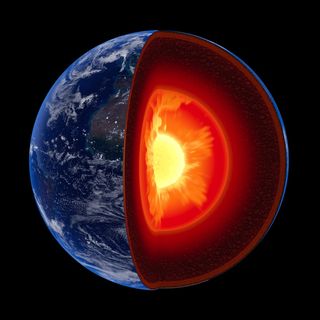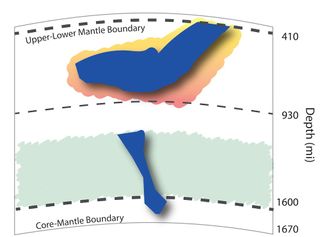Puzzling Layer of 'Stiff' Rock May Lurk Deep Inside Earth

A new layer of stiff rock may unexpectedly exist deep inside Earth, researchers say.
This layer may explain why slabs of Earth's tectonic plates, which make up the outer shell of the planet, can stall as they sink.
Earth is made up of a core of metal, an overlying mantle layer of hot rock and a thin crust on top. Within these layers are divisions; for instance, the core is divided into a solid inner center and a liquid outer layer, and the crust and the upper mantle form a rigid lithosphere 60 to 90 miles (95 to 145 kilometers) deep that is broken up into tectonic plates. [50 Interesting Facts About The Earth]
Oceanic plates collide with continental plates in areas such as the Pacific Rim, triggering earthquakes and volcanic eruptions. In these regions, the leading edges of the oceanic plates can bend into slabs that dive or "subduct" under the continental plates and descend into the mantle. Subduction is a slow process, with a slab taking about 300 million years on average to descend, said study co-author Lowell Miyagi, a mineral physicist at the University of Utah in Salt Lake City.
Mysteriously, prior research that scanned Earth's interior found that many slabs appear to slow down and pool together in the upper part of the lower mantle, at depths of about 930 miles (1,500 km). This has been seen under Indonesia and South America's Pacific coast, the researchers said.
"These observations have been puzzling seismologists for a while, but the consensus in the last year or so is that this is really happening," Miyagi told Live Science.

The discovery of the new layer could help resolve that puzzle. Researchers discovered the potential new layer by crushing minerals between diamonds. There, rock gets three times stronger in the upper part of the planet's lower mantle.
Sign up for the Live Science daily newsletter now
Get the world’s most fascinating discoveries delivered straight to your inbox.
"The Earth has many layers, like an onion," Miyagi said in a statement. "Most layers are defined by the minerals that are present. Essentially, we have discovered a new layer in the Earth. This layer isn't defined by the minerals present, but by the strength of these minerals."
The scientists identified the likely presence of this new layer using X-rays to scan thousands of crystals of ferropericlase, one of the dominant minerals in the lower mantle, as these crystals were squeezed between the tips of two gem-quality diamonds. "You generate very high pressure just by turning the screws on the press by hand with Allen wrenches," Miyagi said in the statement. [Shine On: Photos of Dazzling Mineral Specimens]
This squeezing reached pressures of up to 96 gigapascals, — equivalent to the kind of pressures found in Earth's lower mantle. In comparison, 1 gigapascal is nearly 10 times greater than the pressure at the bottom of the Mariana Trench, the deepest part of the ocean.
The researchers unexpectedly found that ferropericlase's strength begins to increase at pressures equivalent to those at a depth of 410 miles (660 km), which marks the boundary between the upper and lower mantle. This strength increases threefold at pressures found at depths of about 930 miles (1,500 km).
"It's funny — we made these measurements several years ago and never got around to analyzing them, because we sort of assumed we knew what the minerals were going to do," Miyagi said. "But when we looked at the data in detail, instead of this material increasing in strength very smoothly, there was this surprising jump in strength at higher pressures."
Furthermore, when the investigators simulated how ferropericlase might behave deep underground when mixed with bridgmanite, another mineral dominant in the lower mantle, they discovered a great increase in the stiffness or viscosity of the mantle rock. At a depth of 930 miles (1,500 km), this rock is some 300 times stiffer than at the boundary between the upper and lower mantle, which is about 410 miles (660 km) deep. On the pascal-second scale, the viscosity of water is 0.001, peanut butter is 200 and the new mantle layer is 1 billion trillion.
"Once we started looking in detail at this data, it dawned on me that this increase in viscosity was about where seismologists were seeing slabs getting stuck," Miyagi said. "That was a really big moment."
The way this stiff mantle layer may stall the descent of slabs could also help explain some deep earthquakes in the mantle. Most quakes occur at much shallower depths in the crust.
"Anything that would cause resistance to a slab could potentially cause it to buckle or break higher in the slab, causing a deep earthquake," Miyagi said.
In addition, this new layer may hint that Earth's interior is hotter than was previously thought. The stiff rock may decrease the ability of the rock in the mantle to mix. This in turn makes it more difficult "for heat to get out of the Earth, which could mean Earth's interior is hotter than we think," Miyagi said in a statement.
Furthermore, this new layer may explain why different kinds of magma are seen at two different kinds of seafloor volcanoes. In volcanoes, such as those of Iceland, at the midocean ridges at the edges of tectonic plates, magma has the chemical signature of more recent, shallower and well-mixed magma. However, in island volcanoes such as those of Hawaii, the magma is older, from deeper sources and less well-mixed. Miyagi suggested the newfound rock layer may be what separates the sources of the two different magmas that supply the two different kinds of volcanoes.
In the future, the researchers said they hope to see how mixtures of ferropericlase and bridgmanite respond to extremes of both pressure and heat, Miyagi said. He and his colleague Hauke Marquardt, of the University of Bayreuth in Germany, detailed their findings online March 23 in the journal Nature Geoscience.
Follow Live Science @livescience, Facebook & Google+. Original article on Live Science.
